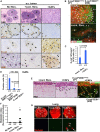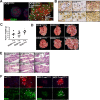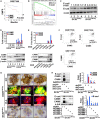Stromal fibroblasts induce metastatic tumor cell clusters via epithelial-mesenchymal plasticity
- PMID: 31331982
- PMCID: PMC6653778
- DOI: 10.26508/lsa.201900425
Stromal fibroblasts induce metastatic tumor cell clusters via epithelial-mesenchymal plasticity
Abstract
Emerging evidence supports the hypothesis that multicellular tumor clusters invade and seed metastasis. However, whether tumor-associated stroma induces epithelial-mesenchymal plasticity in tumor cell clusters, to promote invasion and metastasis, remains unknown. We demonstrate herein that carcinoma-associated fibroblasts (CAFs) frequently present in tumor stroma drive the formation of tumor cell clusters composed of two distinct cancer cell populations, one in a highly epithelial (E-cadherinhiZEB1lo/neg: Ehi) state and another in a hybrid epithelial/mesenchymal (E-cadherinloZEB1hi: E/M) state. The Ehi cells highly express oncogenic cell-cell adhesion molecules, such as carcinoembryonic antigen-related cell adhesion molecule 5 (CEACAM5) and CEACAM6 that associate with E-cadherin, resulting in increased tumor cell cluster formation and metastatic seeding. The E/M cells also retain associations with Ehi cells, which follow the E/M cells leading to collective invasion. CAF-produced stromal cell-derived factor 1 and transforming growth factor-β confer the Ehi and E/M states as well as invasive and metastatic traits via Src activation in apposed human breast tumor cells. Taken together, these findings indicate that invasive and metastatic tumor cell clusters are induced by CAFs via epithelial-mesenchymal plasticity.
© 2019 Matsumura et al.
Conflict of interest statement
The authors declare that they have no conflict of interest.
Figures


















Similar articles
-
Metastatic seeding of human colon cancer cell clusters expressing the hybrid epithelial/mesenchymal state.Int J Cancer. 2020 May 1;146(9):2547-2562. doi: 10.1002/ijc.32672. Epub 2019 Nov 1. Int J Cancer. 2020. PMID: 31506938
-
Glypican-3 induces a mesenchymal to epithelial transition in human breast cancer cells.Oncotarget. 2016 Sep 13;7(37):60133-60154. doi: 10.18632/oncotarget.11107. Oncotarget. 2016. PMID: 27507057 Free PMC article.
-
NRF2 activates a partial epithelial-mesenchymal transition and is maximally present in a hybrid epithelial/mesenchymal phenotype.Integr Biol (Camb). 2019 Jun 1;11(6):251-263. doi: 10.1093/intbio/zyz021. Integr Biol (Camb). 2019. PMID: 31329868 Free PMC article.
-
Zinc Finger E-Box Binding Homeobox 1 Promotes Cholangiocarcinoma Progression Through Tumor Dedifferentiation and Tumor-Stroma Paracrine Signaling.Hepatology. 2021 Dec;74(6):3194-3212. doi: 10.1002/hep.32069. Epub 2021 Sep 28. Hepatology. 2021. PMID: 34297412
-
Epithelial-stromal interactions in human breast cancer: effects on adhesion, plasma membrane fluidity and migration speed and directness.PLoS One. 2012;7(12):e50804. doi: 10.1371/journal.pone.0050804. Epub 2012 Dec 10. PLoS One. 2012. PMID: 23251387 Free PMC article.
Cited by
-
Dual Role of Fibroblasts Educated by Tumour in Cancer Behavior and Therapeutic Perspectives.Int J Mol Sci. 2022 Dec 8;23(24):15576. doi: 10.3390/ijms232415576. Int J Mol Sci. 2022. PMID: 36555218 Free PMC article. Review.
-
Glutamine deficiency drives transforming growth factor-β signaling activation that gives rise to myofibroblastic carcinoma-associated fibroblasts.Cancer Sci. 2023 Nov;114(11):4376-4387. doi: 10.1111/cas.15955. Epub 2023 Sep 14. Cancer Sci. 2023. PMID: 37706357 Free PMC article.
-
Tumour invasion and dissemination.Biochem Soc Trans. 2022 Jun 30;50(3):1245-1257. doi: 10.1042/BST20220452. Biochem Soc Trans. 2022. PMID: 35713387 Free PMC article. Review.
-
Circulating Tumor Cell Clusters Are Cloaked with Platelets and Correlate with Poor Prognosis in Unresectable Pancreatic Cancer.Cancers (Basel). 2021 Oct 20;13(21):5272. doi: 10.3390/cancers13215272. Cancers (Basel). 2021. PMID: 34771436 Free PMC article.
-
Interplay between tumor microenvironment and partial EMT as the driver of tumor progression.iScience. 2021 Jan 28;24(2):102113. doi: 10.1016/j.isci.2021.102113. eCollection 2021 Feb 19. iScience. 2021. PMID: 33659878 Free PMC article. Review.
References
Publication types
MeSH terms
Substances
Grants and funding
LinkOut - more resources
Full Text Sources
Medical
Molecular Biology Databases
Miscellaneous
